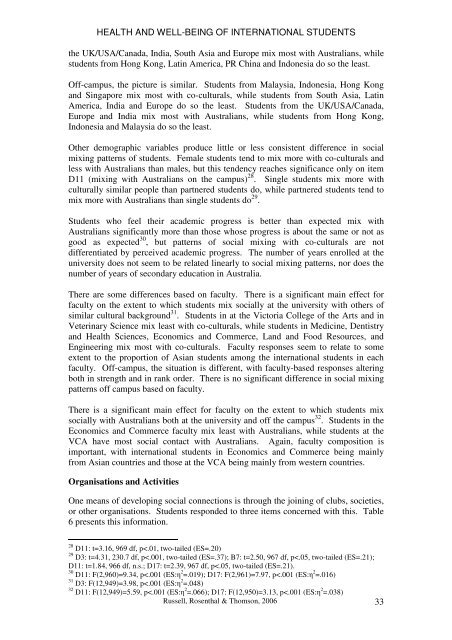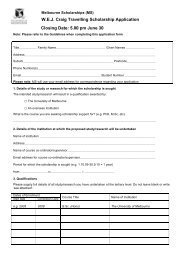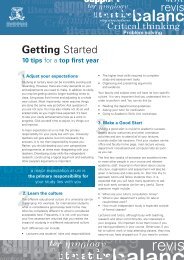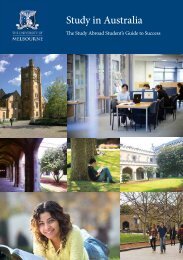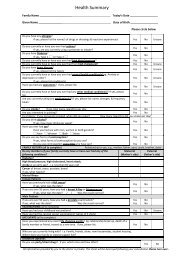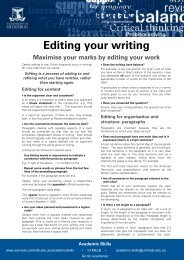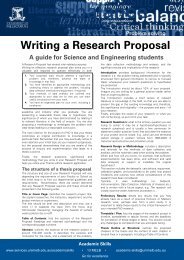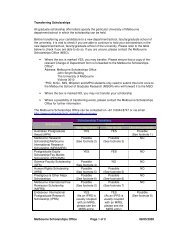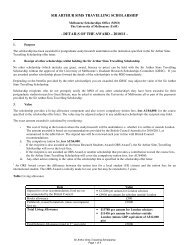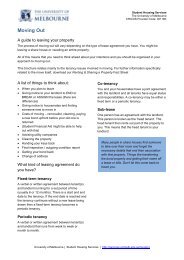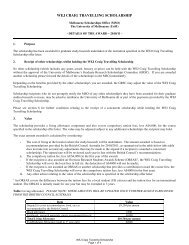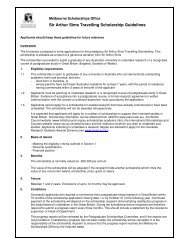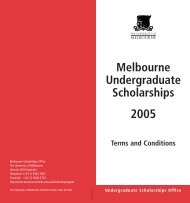a growing experience - Student Services - University of Melbourne
a growing experience - Student Services - University of Melbourne
a growing experience - Student Services - University of Melbourne
You also want an ePaper? Increase the reach of your titles
YUMPU automatically turns print PDFs into web optimized ePapers that Google loves.
HEALTH AND WELL-BEING OF INTERNATIONAL STUDENTSthe UK/USA/Canada, India, South Asia and Europe mix most with Australians, whilestudents from Hong Kong, Latin America, PR China and Indonesia do so the least.Off-campus, the picture is similar. <strong>Student</strong>s from Malaysia, Indonesia, Hong Kongand Singapore mix most with co-culturals, while students from South Asia, LatinAmerica, India and Europe do so the least. <strong>Student</strong>s from the UK/USA/Canada,Europe and India mix most with Australians, while students from Hong Kong,Indonesia and Malaysia do so the least.Other demographic variables produce little or less consistent difference in socialmixing patterns <strong>of</strong> students. Female students tend to mix more with co-culturals andless with Australians than males, but this tendency reaches significance only on itemD11 (mixing with Australians on the campus) 28 . Single students mix more withculturally similar people than partnered students do, while partnered students tend tomix more with Australians than single students do 29 .<strong>Student</strong>s who feel their academic progress is better than expected mix withAustralians significantly more than those whose progress is about the same or not asgood as expected 30 , but patterns <strong>of</strong> social mixing with co-culturals are notdifferentiated by perceived academic progress. The number <strong>of</strong> years enrolled at theuniversity does not seem to be related linearly to social mixing patterns, nor does thenumber <strong>of</strong> years <strong>of</strong> secondary education in Australia.There are some differences based on faculty. There is a significant main effect forfaculty on the extent to which students mix socially at the university with others <strong>of</strong>similar cultural background 31 . <strong>Student</strong>s in at the Victoria College <strong>of</strong> the Arts and inVeterinary Science mix least with co-culturals, while students in Medicine, Dentistryand Health Sciences, Economics and Commerce, Land and Food Resources, andEngineering mix most with co-culturals. Faculty responses seem to relate to someextent to the proportion <strong>of</strong> Asian students among the international students in eachfaculty. Off-campus, the situation is different, with faculty-based responses alteringboth in strength and in rank order. There is no significant difference in social mixingpatterns <strong>of</strong>f campus based on faculty.There is a significant main effect for faculty on the extent to which students mixsocially with Australians both at the university and <strong>of</strong>f the campus 32 . <strong>Student</strong>s in theEconomics and Commerce faculty mix least with Australians, while students at theVCA have most social contact with Australians. Again, faculty composition isimportant, with international students in Economics and Commerce being mainlyfrom Asian countries and those at the VCA being mainly from western countries.Organisations and ActivitiesOne means <strong>of</strong> developing social connections is through the joining <strong>of</strong> clubs, societies,or other organisations. <strong>Student</strong>s responded to three items concerned with this. Table6 presents this information.28 D11: t=3.16, 969 df, p


